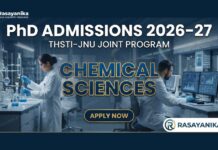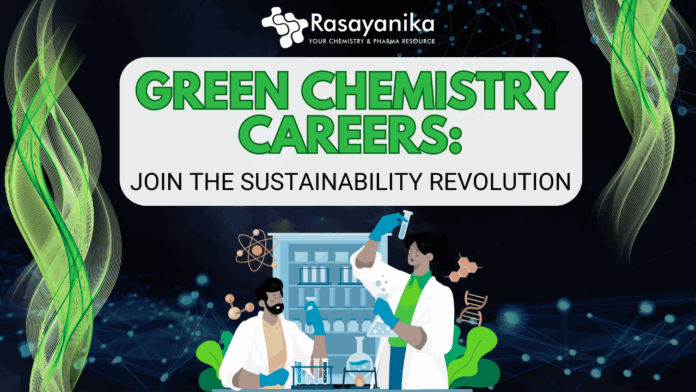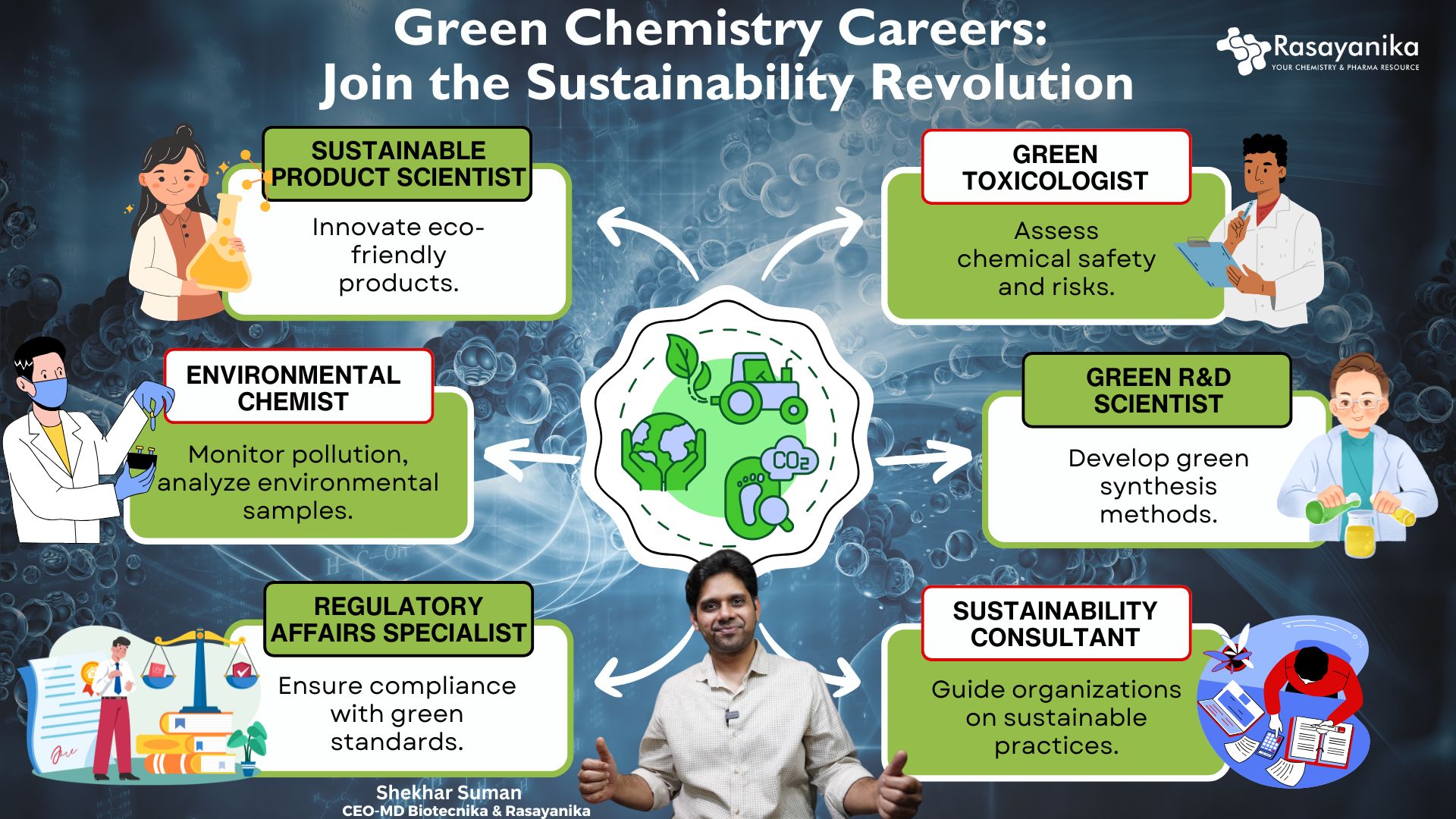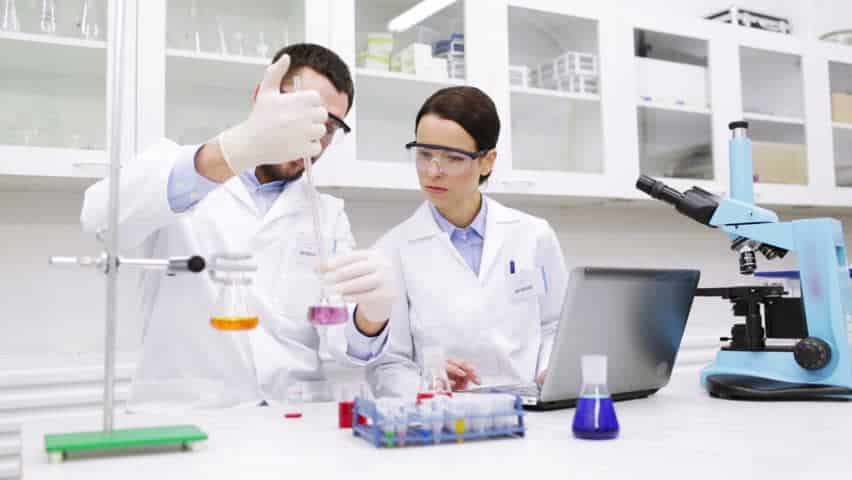Green Chemistry Careers: Join the Sustainability Revolution
Visualize a world where every daily product you use is created without harming our earth, from your coffee to the advanced medications that heal you. This is the actual promise of a sector, “Green Chemistry.” Chemicals play an essential role in our daily lives, yet only a few of us think about the Science behind their sustainability, environmental friendliness, as well as safety. As our world struggles with Environmental challenges, the need for sustainable and innovative solutions is growing. Green Chemistry is a transformative field of sustainability, creativity, and innovation. It transforms product manufacturing and design, thereby conserving resources as well as reducing pollution. As global industries are in the Sustainable race to tackle pressing Environmental challenges, Green Chemistry is leading the way in rewriting the rules of innovation.
Are you excited and curious to know what Green Chemistry is exactly and how you can be an essential part of this Green and clean Technological revolution? Well, then, get ready to discover how you can help build a sustainable, healthier, as well as greener future. Let’s explore right away!
What Is Green Chemistry?
Green Chemistry is the Science of developing chemical products as well as processes that eliminate or reduce the generation as well as utilization of hazardous chemical materials. It is guided by 12 Fundamental Principles, which focus on safer syntheses, waste prevention, renewable resources, as well as energy efficiency. These 12 major principles serve as the blueprint for Green innovation, protecting human health and the planet while enhancing economic efficiency.
The 12 Principles of Green Chemistry:
- Prevention: Rather than cleaning up or treating waste after it occurs, it’s better to prevent waste before it happens.
- Atom Economy: Synthetic methods should be designed to maximize the incorporation of materials used during the synthesis process into final products.
- Less Hazardous Chemical Syntheses: Generate and utilize substances with minimal environmental or human health toxicity.
- Designing Safer Chemicals: Develop products that balance practical functionality with reduced toxicity.
- Safer Solvents and Auxiliaries: Eliminate or minimize the usage of harmful auxiliary substances, such as separation agents, solvents, as well as additives.
- Design for Energy Efficiency: Conduct Synthetic methods under ambient pressure and temperature to minimize energy requirements, thereby reducing their economic and environmental impacts.
- Use Renewable Feedstocks: The feedstock or source raw materials should be derived from renewable and non-depleting resources.
- Reduce Derivatives: To minimize energy and waste use, reduce unnecessary derivatization, such as temporary modification of chemical/physical processes, deprotection/protection, and the use of blocking groups.
- Catalysis: Preference should be given to catalytic reagents over stoichiometric reagents to enhance efficiency.
- Design for Degradation: Design Chemical products so that they break down into innocuous degradation after usage and don’t persistently stay in the environment.
- Real-time analysis for Pollution Prevention: Monitor processes to prevent pollution before it forms. Analytical methodologies should be further developed for in-process, control, and real-time monitoring to prevent hazardous substances from forming.
- Inherently Safer Chemistry for Accident Prevention: The choice of processes and substances should minimize chemical accident risks, such as explosions, fires, as well as chemical releases.
Altogether, these 12 Fundamental Principles shape a better, responsible, and more sustainable approach to the Chemistry sector.
Importance of Green Chemistry
Conventional Chemical practices have contributed extensively to health risks, resource depletion, as well as environmental pollution. According to the WHO (World Health Organization), exposure to hazardous/harmful chemicals causes millions of deaths annually. This is mainly due to chemical poisoning and occupational exposure to Carcinogens such as Asbestos, Benzene, and Arsenic, as well as particulates, which leads to COPD (Chronic Obstructive Pulmonary Disease). This serves as a reminder of why urgent change is necessary.
Global commitments, such as the United Nations’ SDGs (Sustainable Development Goals) as well as the Paris Agreement, encourage global industries to adopt eco-friendly and sustainable practices. Businesses and Governments are investing heavily in Sustainable innovations, enhancing demand for skilled professionals in the Green Chemistry sector.
Career Opportunities in Green Chemistry
Green Chemistry offers rewarding and diverse career paths across various sectors, including industry, academia, non-profit organizations, as well as the Government. Some essential job roles where your skills can shine are listed below:
| Job Role | Description | Key Skills | Industries Hiring |
| Sustainable Product Scientist or Green Chemist | Develops eco-friendly processes and chemicals | Chemical Engineering, Organic Chemistry, and Toxicology | Pharmaceuticals, Materials Science, and personal care |
| Environmental Chemist | Analyze pollutants and design pollutant control measures | Instrumentation, Regulations, and Analytical Chemistry | Consulting firms, Environmental laboratories, and the Government |
| Regulatory Affairs Specialist | Ensure products comply with the Environmental Laws | Compliance, Documentation, and Legal Knowledge | Biotechnology, pharmaceutical, and Chemical Manufacturing industries |
| Sustainability Consultant | Advise Organizations on Green and Sustainable practices | Life Cycle Assessment, Stakeholder Engagement, and Environmental Management Systems | All the industrial sectors |
| Green Research & Development Scientist | Innovate safer synthesis methods and formulations | Synthesis, Problem-solving, and Laboratory Research | Chemicals, Pharmaceuticals, and Materials Industries |
| Green Toxicologist | Evaluate chemical risks and safety | Biology, Toxicology, and Risk Assessment Models | Regulatory Agencies and Research Institutes |
An aspiring professional can gain experience and expertise through volunteering, certifications, as well as internships, thereby accelerating their career growth in Green Chemistry.
Major Industries Driving Green Chemistry Innovation
Green Chemistry was once a niche concept, but it has now evolved into a core strategy across multiple major industries, driven by consumer demand, Sustainability goals, as well as Regulatory mandates.
- Cosmetics: Develop biodegradable and natural cosmetic formulations that are free from harmful microplastics, with eco-friendly and sustainable packaging aligning with clean and Green beauty trends.
- Pharmaceutical Industries: Innovate drug synthesis by replacing harmful and toxic solvents with biodegradable solvent alternatives as well as integrating renewable resources for cost-effective and safer drug production.
- Automotive & Energy: Producing eco-friendly fuels, lubricants, and materials to lower carbon footprints.
- Agriculture: Develop bio-based fertilizers, pesticides, and Agricultural utilities that reduce contamination while protecting beneficial organisms, thereby supporting Sustainable Agricultural practices.
- Packaging: Design compostable, Biodegradable, as well as recyclable materials that eventually reduce harmful environmental impact.
- Food Industry: Utilize fermentation-derived compounds and natural preservatives to replace synthetic compounds and additives, enhancing shelf life and food safety.
As major industries adopt Green Chemistry, skilled professionals with expertise in Sustainability are in high demand.
Emerging Technologies
Green Chemistry is dynamic and powerful, intersecting with advanced and futuristic technologies that aid Sustainability forward, such as:
- Mechanochemistry: Driving Chemical reactions with Mechanical energy, mainly to eliminate the need for Chemical solvents.
- Biocatalysis: Reduced waste and reaction efficiency boost by utilizing catalysts and enzymes.
- AI (Artificial Intelligence) and Data-Driven Chemistry: Applying AI-ML (Machine Learning) to predict toxicity, design greener compounds, and optimize reactions.
- Renewable Feedstocks: Replace petrochemical feedstocks with sustainable feedstocks such as agricultural waste, microbial sources, or biomass
- Flow Chemistry: Continuous Green Chemical manufacturing techniques enhance scalability, resource utilization, as well as safety.
Mastering these emerging trends can offer a competitive advantage in this rapidly evolving field.
Educational Pathways for Career
A Bachelor’s in Chemical Engineering or Chemistry is required, although the Green Chemistry career path is increasingly accessible through specialized Green Chemistry and Sustainability certifications and courses.
Educational route:
- Bachelor’s or Master’s Degrees: Take courses such as Environmental Chemistry, Chemical Engineering, and Green Chemistry, with sustainability modules included.
- PhD (Doctor of Philosophy) Programs: Focused on Toxicology, Renewable Resources, or Sustainable Synthesis.
- Online Courses and Certifications: Available through professional societies, such as the ACS (American Chemical Society) and Ed-tech platforms.
Essential Skills to develop:
- Teamwork and strong communication capabilities.
- Knowledge of global and local Environmental Compliance and Regulations.
- Green synthesis laboratory expertise methods.
- Proficiency in Data interpretation and Analytical instruments
Involvement in Sustainability projects, Green Chemistry competitions, as well as Internships can enhance your career profile.
Conclusion
Green chemistry is a global movement aimed at making our planet safer and healthier. Whether you are innovating recyclable materials, shaping Environmental Policies, or developing non-toxic household products, every significant contribution matters.
In a world where every innovation must serve both progress as well as the planet, Green Chemistry professionals are more essential than ever. This field seeks professionals who dare to dream bigger, act responsibly, as well as lead with purpose. From the laboratory bench to the boardroom, your skillful knowledge can spark lasting change, developing safer chemicals, reimagining industrial processes, and pushing the boundaries of Sustainable Science.
Now is the time to align your career with impact. Explore Green Chemistry education, sharpen your skills, as well as contribute to innovations that matter. The world needs thinkers, creators, as well as changemakers who believe that Science can be both responsible as well as powerful.
So go ahead and embrace the revolution! Learn boldly, innovate fearlessly, and act with integrity. Shape the future one sustainable solution at a time.
The future of Chemistry is Green. Are you excited to be a part of it?















































